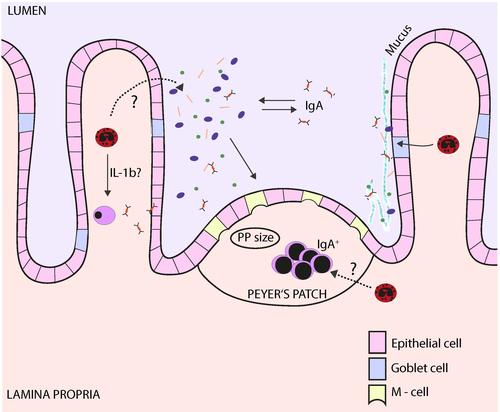Regulatory eosinophilic granulocytes in nematode infections
Schematic overview of the functions of intestinal eosinophilic granulocytes. (Click on the image for a detailed legend.)
Image Credit: Institut für Immunologie
Eosinophilic granulocytes are strongly increased in helminth infections. Under homeostatic conditions eosinophils provide support for antibody class switching in favour of IgA in the mucosa-associated lymphatic tissues. We are interested in the role of eosinophils in infections with the intestinal nematode Heligmosomoides polygyrus in the mouse.
In the absence of eosinophils, the fecundity of the worms is reduced which is associated with an increased Th2 response and stronger IgG1 production of B cells in the Peyer’s patches. Via regulation of the IL-4 response by follicular T helper cells, and thereby the IgG1 response in nematode-infected hosts, eosinophils play an important role in the maintenance of the intestinal IgA responses in the helminth-infected host (Strandmark et al., Mucosal Immunology, 2016; Strandmark et al. Critical Reviews in Immunology, 2016; figure).
Selected publications:
- Strandmark, J., S. Steinfelder, C. Berek, A. Kühl, S. Rausch, S. Hartmann. 2016. Eosinophils are required to suppress Th2 responses in Peyer’s patches during intestinal infection by nematodes. Mucosal Immunology, doi:10.1038/mi.2016.93.
- Strandmark J., S. Rausch, S. Hartmann. 2016. Eosinophils in homeostasis and their contrasting roles during inflammation and helminth infections. Critical Reviews in Immunology, DOI: 10.1615/CritRevImmunol.2016018726.
Associated scientists: Dr. Sebastian Rausch, Ivet Yordanova.
